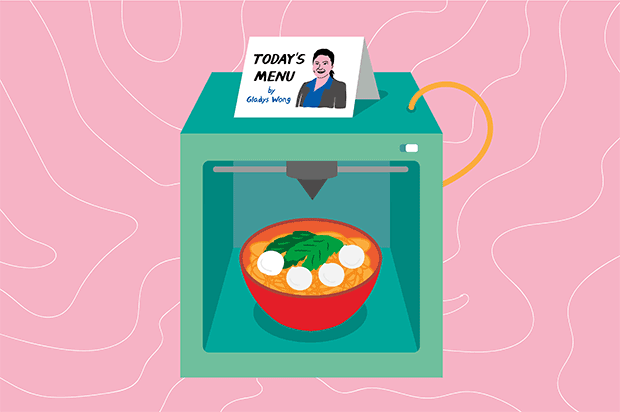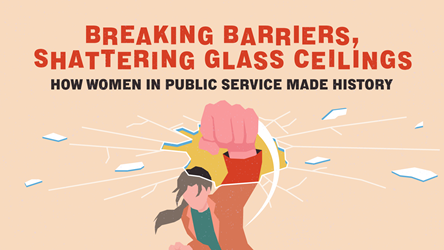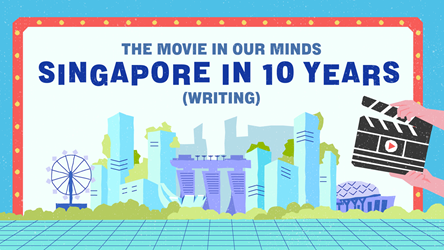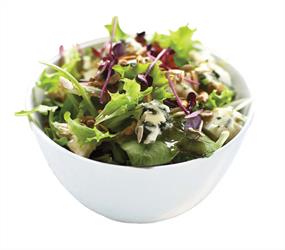Fresh from the 3D printer: healthy, tasty meals

Imagine a senior in his 70s or 80s, living alone. He’s still fairly healthy and loves his food, but has trouble chewing and swallowing solids so he has to settle for a soft diet of oatmeal, porridge or pureed food every day. Eating has become a bore and a chore, and he may risk becoming malnourished.
What if he could order a pureed meal that is 3D-printed to look like seafood hor fun, customised to his nutritional needs and, best of all, tasty? Now there is joy once again in eating.
That is the dream of Ms Gladys Wong, Chief Dietitian at Khoo Teck Puat Hospital (KTPH), who believes that “food is not nutrition unless it’s eaten”. Currently, patients with dysphagia (difficulty in swallowing) are served pureed food that is visually unappealing. As a result, patients are turned off and may eat very little.
“If you can make it nice and shapely, like the real thing, then you increase their chance of eating it, and you lower their risk of malnutrition, which is on the rise in Singapore,” explains Ms Wong, who heads the KTPH Nutrition Department.
In other countries, silicone moulds have been used to make pureed food more visually attractive, but that’s still not the best solution as it takes significant manpower and effort to get the right texture and nutritional mix.
Hence, Ms Wong began toying with the idea of using 3D food printing to create nutritionally customised and delicious meals.
How it began
The idea of 3D printing is not new. The hospital had already been exploring how dentists and surgeons could use 3D printing for dentures and prostheses. But it was only through a few serendipitous circumstances that the idea of printing food took hold.
In March 2015, Ms Wong and her colleague visited Nanyang Polytechnic’s 3D-printing facility with the intention of printing food display models for patient education. But as she delved deeper into 3D printing, she saw that the technology could be used to print real food.
Soon after, she attended a presentation in Brussels on 3D food printing for people with chewing and swallowing problems. This showed her how the idea can improve productivity and be commercially viable. She returned to Singapore with the conviction that 3D-printed food could also be adopted by local hospitals, nursing homes and Singapore’s elderly population.
She shared her idea with Professor Chua Chee Kai, the Executive Director of the Centre for 3D Printing at Nanyang Technological University Singapore (NTU Singapore). He supported her vision and got a PhD student, Mr Mervin Tee, to work on this project.
Obstacles and opportunities
While Western meals – say, a piece of steak with boiled carrots and peas on the side – usually consist of distinct ingredients that can easily be 3D-printed, local dishes such as char kway teow tend to be a mix of ingredients. And that is something the NTU Singapore-KTPH team is looking into as they develop the technology.
“There are multi-layer nozzles where you can print cross-section, not just by layers, but in multi-dimension,” says Ms Wong. So when you print a plate of char kway teow, you can identify the tau gay(bean sprouts), cut chilli, kway teow noodles, see hum (cockles). It’s puree but you can see the form.”
3D-printed char kway teow will look, smell and taste like a steaming hot plate from the hawker centre, with the actual ingredients and wok hei fragrance (an attractive, charred aroma from stir-frying), but its texture would be like mousse or puree.

The main conundrum the team is facing at this stage of their research is how to print the food and ensure the pureed material will keep its shape, especially after cold storage and reheating before eating. They are trying to create a gelling agent to hold the printed dish together without compromising on its taste and structure.
To deliver precise nutrition to each person, Ms Wong hopes each dish will be printed in accordance to each customer’s health data. This means additional nutrients such as vitamins and minerals could be infused into the puree before it is printed into a dish. This is where the KTPH dietetics team’s expertise comes in.
But this dream of customised 3D-printed food and making it financially viable for community hospitals and nursing homes is still some distance from reality.
The NTU Singapore-KTPH team recently received their first grant from the National Additive Manufacturing Innovation Cluster in July 2017 and is still looking for more collaborators.
Future partners would include dietitians, food technologists and software designers to develop local dishes that are nutritionally adequate, tasty and printable; food suppliers to provide the “food ink cartridges”; catering companies to coordinate the printing and delivery of meals; government agencies to advise on the safety legislation of food production; packaging companies to design innovative packaging suitable for 3D printing and engineers to develop large-scale 3D food printers.
“If we collaborate with the right partners to innovate together, I'm sure we can create an efficient infrastructure from ordering to production to the table,” says Ms Wong.
What drives Ms Wong and her team is a desire to make a difference to patients.
“We want the nursing home residents and those living alone at home who require pureed diets to be able to access them easily,” she says. She also hopes that they find their 3D-printed meals “moreish”, as she describes it, or having such as pleasant taste that they will want to eat more.
- POSTED ON
Sep 27, 2017
- TEXT BY
Yvonne Cheong
- ILLUSTRATION BY
Mushroomhead
-
Work Better
Instruction Manual February 2018









